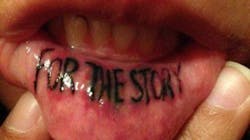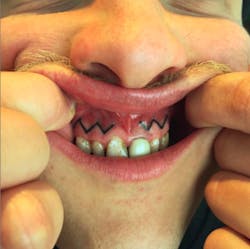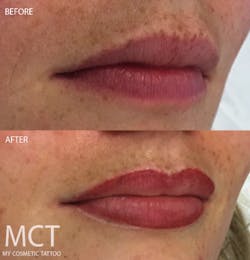Intraoral and cosmetic tattoos: Ink about it!
By Sunisa Thongkam, SDH, Michelle Wong, SDH, & Gail Aamodt, RDH, MS
Intraoral and cosmetic tattoos have been a part of religious and cultural traditions throughout history (Telang, 2015). Today, they are becoming more mainstream as their popularity rises. In 2015, Khunger, in the Journal of Cutaneous and Aesthetic Surgery, reported an exponential increase of decorative tattooing in teenagers and young adults as well as a definitive increase in clients wanting to remove existing tattoos. Tattoos, including names or religious symbols, are increasingly removed to psychosocial reasons (Khunger, 2015).
Tattoos need not be limited to the skin. With new emerging beauty trends, cosmetic tattoos such as lip liner, eyeliner, and eyebrow tattoos are sought by clients to enhance cosmetic features. Intraoral tattoos on the inner labial mucosa, gingiva, and hard palate are being seen with more frequency as a form of self-expression.
Training
The requirements to become a licensed tattoo artist vary across the United States. In Oregon, the requirements include completion of an approved tattoo artist training program, and successful completion of a written exam through the National-Interstate Council of State Boards of Cosmetology (NIC). A tattoo artist’s training program includes 50 documented procedures, 150 hours of practice, 360 hours of training, and 210 hours of theory. The written exam has a variety topics ranging from infection control, blood borne pathogens, and skin diseases. Tattoo artists are required to maintain a current CPR and first aid certification to hold their license (Oregon.Gov, 2019).
At this time, no additional courses or training are required to complete intraoral or cosmetic tattoos. Some tattoo artists choose to have an apprenticeship to gain further knowledge of specialized tattooing procedures. Unfortunately, a literature review revealed the number of inadequately trained tattooists and piercers has increased which creates more complications due to services being done without proper knowledge of health and hygiene rules (Quaranta, 2011). More importantly, the FDA has not placed any regulation on materials used during the tattooing process.
The public, especially young adults, may receive tattoos without knowledge of the risks and benefits of the process. A study conducted by Patrycja Rogowska in 2017 identified that young adults often seek tattoos without proper background knowledge of the process or of the contraindications for tattooing. Based on the study, their tattoo artists’ did not ask about the client’s current state of health, any chronic illnesses, or medications taken, and a written consent was not required for the procedure. Also, over half of those surveyed admitted the tattoo artist did not check whether the wound was healing properly.
Intraoral Tattoos
The rate of pigment rejection is believed to be much higher in the lip. Some tattoo artists report that the elasticity of the lip requires more technical knowledge and experience. Most tattoo artists choose not to offer intraoral tattoos because clients do not understand that ink does not last long in the oral cavity, which leads to unhappy clients because of the fading process. Those artists who still offer intraoral tattoos often require clients to sign a waiver prior to the procedure.
Pathology
An oral pathologist was interviewed to understand another perspective on intraoral tattoos. The pathologist believes that intraoral tattoos are overall relatively safe, however, oral diseases such as periodontal disease or poor home care could increase the risk of an infection due to the patient’s higher bacterial load in the oral cavity. The pathologist was not aware of any known side effects an intraoral tattoo may have on the rest of the oral cavity, and she rejected the idea that the substances in tattoo ink rub against the gingiva and potentially cause gingival recession. Intraoral tattoos can instigate an allergic reaction related to the red dye that may contain cinnabar (an extract from cinnamon that is known to cause an irritative effect on the oral cavity). The pathologist recommended that tattoo artists be aware of issues with tattoo ink and the vascularity of the oral mucosa.
Allergic responses can be prevented through strict aseptic techniques and the use of uncontaminated ink. Other potential complications include local infections, systemic infection, photodermatitis, and granulomatous and lichenoid reactions. Strict aseptic precautions seem to be the key to prevent these reactions. Instruments should be sterile or preferably disposable. At this time, there is no current legislation to promote safe tattooing practices.
Adverse reactions are rare and unpredictable. The number of skin cancers with tattoos are seemingly low and thus the association is considered coincidental (Kluger, 2012). The most common reactions include immune-mediated responses and skin infections. Reported infections related to hepatitis and HPV in tattoos have decreased significantly; the transmission of these diseases is almost nonexistent in the present day as long as the tattoo is done in a professional parlor and with disposable needles (Islam, 2016). Skin and patch testing is available for clients to determine if they will have an immunogenic reaction to ink. Granulomatous reactions happen when the individual’s immune system attempts to wall off substances that the body thinks is foreign, such as tattoo ink. Lichenoid reactions clinically appear similar to lichen planus, which presents as recurrent and small papules that may coalesce with rough scaly plaque.
In 2017 the frequency of tattoo complications was at about 2% and is increasing due to the popularity of tattoos within the last five years (Rogowska, 2017). However, in-depth studies about tattooed individuals are needed to truly understand the many complications that can occur.
Healing
All tattoos require time to heal. The most common healing process is based on the moist wound healing principle (MWH). The MWH principle is a localized healing method and follows the concept that tattoos should heal, without infection, when they remain covered. MWH utilizes plastic film, hydrocolloids, silver dressing, and compressions to cover the tattoo (Serup, 2017). For a few days after receiving any type of tattoo, patients are told to cover the tattooed skin with moisturizing ointments or creams, and a wrap of transparent foil or saran wrap. Local antibiotics are rarely used because of the possible risk of the host becoming resistant to certain strains of antibiotics (Serup, 2017). Compressive bandages can be applied to help control the healing wound.
Overall, tattoo healing is dynamic and depends on the health of the individual. Those who are immunocompromised may experience more difficulty with the healing process. It is important to note that tattoos remain sensitive and vulnerable to sunlight until they are fully healed. It is recommended that clients apply sunscreen to all exposed tattoos before going out in the sun. The photosensitivity may induce a photochemical breakdown of the tattoo pigment, which can cause itching. The reaction is mostly cosmetic and can cause bleaching of the tattoo color over time (Serup, 2017).
No general consensus of post-care instructions could be found in the literature review. Artists we talked with reported there are many variations in post-care instructions and it is solely up to the tattoo artist’s preferences and knowledge. Intraoral tattoos need more specialized post-care instructions due to their location. Instructions may include avoiding certain foods and liquids that could irritate the tattoo. or additional cleansing of the area with a mouth rinse.
Recommendations
• Approach the subject in a non-judgemental manner. Clients should be comfortable discussing the potential risks of getting an intraoral tattoo with their medical and/or dental provider.
• Be ready to explain the tattooing and healing process before receiving any type of tattoo.
• Explain the importance of achieving oral health before receiving an intraoral tattoo. To prevent the possibility of any complications, encourage patients to postpone tattoos until they are in good overall health.
• Encourage patients to ask questions of the dental professional and the tattoo artist.
• Stress the importance of seeking tattoos from licensed tattoo artists only.
• Report any complications to the tattoo artist and seek medical care as needed.
Finally, dental providers should support regulation of tattoo inks and procedures. Hopefully by sharing this information with their patients and other providers, they can help identify and treat intraoral and cosmetic tattoo complications. Eventually, regulation of tattoo inks and procedures may help prevent adverse reactions and complications.
References
• Islam PS, Chang C, Selmi C, Generali E, Huntley A, Teuber SS, Gershwin ME. (2016). Medical Complications of Tattoos: A Comprehensive Review. Clinical Reviews in Allergy & Immunology,50(2), 273-286. doi:10.1007/s12016-016-8532-0
• Kluger N, Koljonen V. (2012). Tattoos, inks, and cancer. Lancet Oncol, 13, 161–168.
• Quaranta A, Napoli C, Fasano F, Montagna C, Caggiano G, Montagna MT. (2011). Body piercing and tattoos: A survey on young adults knowledge of the risks and practices in body art. BMC Public Health,11(1). doi:10.1186/1471-2458-11-774
• Rogowska P, Szczerkowska-Dobosz A, Kaczorowska R, Słomka J, Nowicki R. (2017). Tattoos: Evaluation of knowledge about health complications and their prevention among students of Tricity universities. Journal of Cosmetic Dermatology,17(1), 27-32. doi:10.1111/jocd.12479
• Serup J. (2017). Medical Treatment of Tattoo Complications. Current Problems in Dermatology,52(74), 81st ser. doi:10.1159/000450804
• Serup J, Sepehri M, Carlsen KH. (2016). Classification of Tattoo Complications in a Hospital Material of 493 Adverse Events. Dermatology,232(6), 668-678. doi:10.1159/000452148



